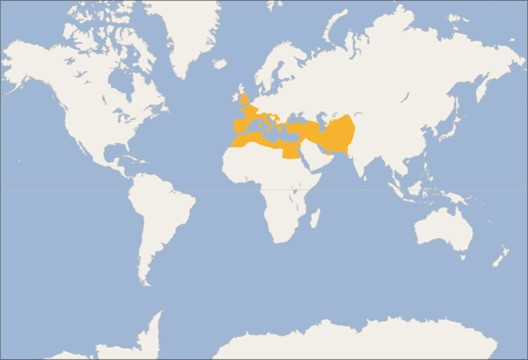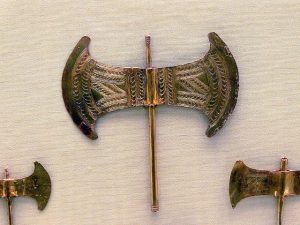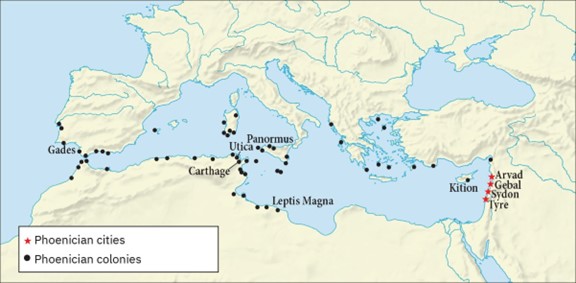30 Early Mediterranean Peoples
During the Bronze Age (c. 3300–1200 BCE), trade connected the peoples and cultures of Greece and the Aegean islands such as Crete. By the third millennium BCE, the inhabitants of these lands were already producing wine and olive oil, products in high demand in ancient Egypt and the Near East. The Aegean Minoan and Mycenaean civilizations of the Late Bronze Age (c. 1600–1100 BCE) thus shared in the economic prosperity and cultural interaction that linked the eastern Mediterranean with the ancient cultures of western Asia.
The eventual collapse of the Late Bronze Age world coincided with the development of new technology that allowed people to devise iron tools and weapons. During the new Iron Age, the Phoenicians not only preserved Bronze Age cultural traditions but they also developed a revolutionary new communication tool, the alphabet, that vastly expanded literacy. They established trading posts across the Mediterranean as far as Spain, often in search of new sources of iron ore and other metals such as tin. The arrival of the Phoenicians and Greek traders in the western Mediterranean brought them into contact with the Etruscans in the Italian peninsula. Thus, the period from the Bronze Age through the Iron Age witnessed the development of numerous cultures across the Mediterranean.

Minoan Crete and Mycenaean Greece
By 2000 BCE, a unique culture had developed on the Aegean island of Crete, reaching the height of its power at the beginning of the Late Bronze Age around 1600 BCE. The later Classical Greeks told the myth of King Minos of Crete, who built a giant maze known as the Labyrinth and imprisoned there a half-man, half-bull called the Minotaur (the “Bull of Minos”). To avenge his own son’s death, Minos forced young men and women from Athens in Greece to enter the Labyrinth and be eaten by the monster. Historians see in the myth a distant memory of the earlier civilization on Crete and use the term Minoan, derived from Minos, to describe it.
The Minoans built spacious palaces on Crete, the largest at Knossos. Since these were usually unfortified, historians believe Crete was generally peaceful and united under a single government with Knossos as the capital. The Minoans also established settlements and trading posts on other Aegean islands such as Thera and along the Anatolian coast. Their palaces were huge complexes that served as economic and administrative centers.
A common weapon and symbol in these palaces was the labrys, or double ax, from which the word “labyrinth” arose. In the courtyards, young men and women participated in bullfights that may be the basis for the myth of the Minotaur. Frescoes on the palace walls depict these fights as well as sea creatures and scenes from nature. The Minoan religion revered bulls and a goddess associated with snakes, nature, and fertility. The abundance of figurines of this snake-wielding female deity and other artistic depictions of women may mean that at least some women enjoyed high social status in Minoan society. Religious rituals were practiced in small shrines as well as on mountain tops and in caves and sacred forests.

Link to Learning
For a thorough examination of the art and archaeology of the Aegean Bronze Age, visit Dartmouth University’s Aegean Prehistoric Archaeology (https://openstax.org/l/77AegeanPre) website.
Sometime around 1500 BCE, the palaces on Crete were destroyed. Bronze Age Greeks appear to have migrated from the Balkans into mainland Greece around 2000 BCE and adopted Minoan civilization around the beginning of the Late Bronze Age, in 1600 BCE. Unlike the Minoans, the Mycenaean Greeks were divided into a number of separate kingdoms. Immense palace complexes like those at Knossos have been found at Mycenae, Tiryns, Thebes, Pylos, and Sparta, sometimes surrounded by monumental fortifications. These locations correspond to the powerful kingdoms described in the later Greek epic poem the Iliad, attributed to the poet Homer. This poem tells the story of the Trojan War, in which the Greek kingdoms, led by King Agamemnon of Mycenae, waged war against the city of Troy.
The last century of the Late Bronze Age, after 1200 BCE, was a period of wars and invasions that witnessed the collapse of many powerful states. The palaces of Mycenaean Greece were destroyed, perhaps following revolts by the lower class and natural disasters like climate change and earthquakes. In the centuries that followed, the population declined drastically, writing and literacy disappeared, and Greece entered a “Dark Age.”
Later ancient Greek historians reported that Greek-speaking tribes known as the Dorians migrated from northwest Greece to the south after the Trojan War. The instability in Greece and the Aegean resulted in much migration by people in search of new homes. For instance, ancient Egyptian inscriptions tell us that the “Sea Peoples” destroyed the Hittite Empire and numerous kingdoms in the Levant to the north of Egypt. One particular group known as the Philistines (Peleset), who attacked Egypt, eventually settled just north of Egypt along the coast of the southern Levant. But there were many others, including the Akawasha, Lukka, Shardana, Tursha, and more who washed across the eastern Mediterranean during the Late Bronze Age Collapse.
Other groups were also on the move. Libyans, who inhabited the North African coastal region west of Egypt, invaded the northern Nile River valley and settled there. The attacks of the Sea Peoples and Libyans contributed to the later collapse of Egypt’s central governments after 1100 BCE, ending the New Kingdom period. Phrygians, who inhabited the Balkans in southeast Europe, migrated into Asia Minor (Turkey). The Aramaeans, nomadic tribes who spoke a Semitic language and inhabited the Arabian Desert, migrated into Syria and Mesopotamia.
These wars and invasions coincided with an important technological innovation, the birth of sophisticated iron-making technology. For thousands of years, bronze had been the metal of choice in the ancient world. But the disruptions caused by the Late Bronze Age Collapse made it difficult for metal workers to access tin, a crucial ingredient in bronze. Without a sufficient supply of tin, artisans experimented for centuries with iron ore. In the process, they developed the techniques of steeling (adding carbon to the iron to make it stronger), quenching (rapidly cooling hot iron with water), and tempering (heat treating) to produce a metal far superior in strength to bronze. By around 900 BCE, the Iron Age had begun in the eastern Mediterranean.
Phoenicians, Greeks, and Etruscans
The Phoenicians were descended from the Bronze Age Canaanites and lived in cities like Sidon and Tyre (in today’s Lebanon), each ruled by a king. They were great sailors, explorers, and traders who established trading posts in Cyprus, North Africa, Sicily, Sardinia, and Spain. They sailed along the west coast of Africa and to the British Isles in search of new markets and goods such as tin.

Around 1100 BCE, the Phoenicians also invented the world’s first known alphabet, using symbols that represented consonant sounds. Strung together, these consonants created words in which vowel sounds were interpreted by the order of the consonants. Because the Phoenician alphabet simplified the earlier script of the Canaanites, more people could now become literate, not just a small, specialized group of scribes. The Phoenicians’ commercial success was undoubtedly partly a result of their better, more efficient record- keeping system that a larger population could learn and employ. Other cultures like the Aramaean peoples and the Israelites quickly adapted the new script to their own languages. By the eighth century BCE, the Greeks had also adopted and later adapted the Phoenician alphabet to write their language.
Core Impact Skill: Persuasion
As you reflect on the Phoenicians’ development of a written alphabet, take a moment to consider how revolutionary this innovation was—and how it changed the way people communicated, recorded ideas, and influenced others. What did it mean to move from oral storytelling or pictographs to a streamlined writing system that many people could learn? How did this new tool allow people not only to record trade agreements but also to shape beliefs, spread values, and build trust between strangers?
Persuasion helps you explore these questions by showing how writing empowered people to influence others across space and time. The Phoenician alphabet was more than a merchant’s tool—it became a powerful form of communication, enabling ideas to travel farther and carry more authority.
-
How did written language help merchants persuade others to trust a trade agreement?
-
How did writing strengthen a ruler’s ability to unify a diverse population?
-
How did the use of written symbols give religious or political leaders more control over a message than oral tradition alone?
By examining how writing became a tool of persuasion, you are not just learning about technological change—you are uncovering how human beings have shaped power, culture, and relationships through communication. That was the heart of persuasion then—and it remains vital today.
Beginning with the Assyrian Empire’s expansion in the eighth century BCE, the Phoenician kingdoms became subjects of the successive Iron Age empires of western Asia: the Assyrians, the Chaldeans (Neo-Babylonian), and the Persians. The Phoenicians continued to flourish, however. The Assyrians valued Phoenician artists, and finely crafted Phoenician wares such as jewelry and furniture became popular among the ruling elites. The Persians relied largely on Phoenician sailors and ships to serve as the naval forces, especially in their campaigns to conquer Greece in the early fifth century BCE. When Phoenician city-states such as Sidon and Tyre became subject to foreign rule, many Phoenicians immigrated to the city of Carthage (in modern-day Tunisia), founded by Phoenician merchants around 700 BCE as a stopping place on the long but profitable voyage to Spain. Given this influx of immigrants, Carthage grew large and wealthy, and by the fifth century BCE the southern Italian peninsula was the dominant power in the western Mediterranean.
The Phoenicians were not the only people establishing colonial outposts around the wider Mediterranean world. Beginning in the eighth century, Greeks began founding colonies in North Africa, in coastal Spain and France, on the shores of the Black Sea, and on the Italian peninsula. Many of these colonies were built in resource-rich areas and commonly produced grain, tin, or timber for export back to Greece. Others served more mercantile interests, trading with major and minor powers across the Mediterranean. It was through these colonial ventures that Greeks and Phoenicians came into contact with the Etruscans of the northern Italian peninsula.
The Etruscans were organized into independent city-states such as Veii and Vulci, much like the Greeks were, and each city was ruled by its own king and council of elders. In their art and architecture, the Etruscans followed Greek models. They modified the alphabet the Greeks had acquired from the Phoenicians to write their language, which scholars have not yet fully deciphered. By 600 BCE, they had expanded beyond their base in modern Tuscany and colonized Rome, which became an Etruscan city. They also founded new colonies in northern and southern Italy. The Etruscan states remained the dominant power in the Italian peninsula until 474 BCE. In that year, at the Battle of Cumae off the coast of southern Italy, the naval forces of the Greek city-state of Syracuse won a decisive victory over the Etruscan fleet and emerged as the chief power in the region, along with Carthage.
Since ancient Rome began as an Etruscan city-state, the Etruscans strongly influenced the development of Roman culture. For example, Roman priests divined the will of the gods by examining a sacrificed animal’s entrails, a custom adopted from the Etruscans. The Etruscans honored their dead with elaborate tombs, and the Romans did the same, maintaining that the spirits of their ancestors watched over them. Gladiatorial contests in Rome had origins among the Etruscans, who at funerals forced prisoners of war to fight to the death as human sacrifices to their dead. The fasces, a bundle of rods and an ax that symbolized the authority of Roman magistrates, originally denoted the authority of Etruscan kings. Finally, the Roman alphabet, still used in western and central Europe today, was based on Etruscan modifications to the Greek alphabet.
